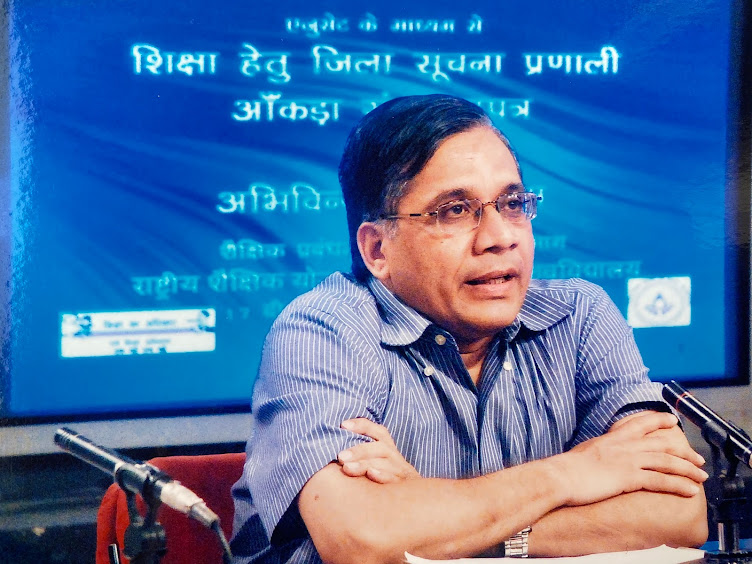Tuesday, August 26, 2008
DISE 2007-08 Publications
 Contributed significantly towards strengthening EMIS in India through the Government of India's flagship programme, District Information System for Education (DISE) which acclaimed National and International recognition. Because of the efforts made, the time-lag in educational statistics has drastically come down from earlier eight years to less than a year at the national level & only a few months at the state and lower levels. Since 2012-13, statistics generated through Unified-DISE attained the status of the Official Statistics and school education plans across the Country are being formulated exclusively based on the U-DISE data. Authored seven books and published numerous articles and brought out national reports for about 15 years based on U-DISE data at NIEPA, New Delhi.
https://educationforallinindia.com/about-prof-arun-c-mehta/
Contributed significantly towards strengthening EMIS in India through the Government of India's flagship programme, District Information System for Education (DISE) which acclaimed National and International recognition. Because of the efforts made, the time-lag in educational statistics has drastically come down from earlier eight years to less than a year at the national level & only a few months at the state and lower levels. Since 2012-13, statistics generated through Unified-DISE attained the status of the Official Statistics and school education plans across the Country are being formulated exclusively based on the U-DISE data. Authored seven books and published numerous articles and brought out national reports for about 15 years based on U-DISE data at NIEPA, New Delhi.
https://educationforallinindia.com/about-prof-arun-c-mehta/
Tuesday, August 19, 2008
Visit to Lakshadweep
Recently along with Mr. Shalender Sharma (of DISE Project) I visited Kavaratti, the capital of
First thing first, reaching Kavaratti is not simple। One has to first reach
Practically within half an hour we moved around Agatti and came back to the Guest House। We were still not sure about our flight to Kavaratti, the next morning. Initially we were told that the Helicopter may not come to Agatti, as it is still in the
Our return journey was also quite uncertain. It took almost 12 hrs to reach
 Contributed significantly towards strengthening EMIS in India through the Government of India's flagship programme, District Information System for Education (DISE) which acclaimed National and International recognition. Because of the efforts made, the time-lag in educational statistics has drastically come down from earlier eight years to less than a year at the national level & only a few months at the state and lower levels. Since 2012-13, statistics generated through Unified-DISE attained the status of the Official Statistics and school education plans across the Country are being formulated exclusively based on the U-DISE data. Authored seven books and published numerous articles and brought out national reports for about 15 years based on U-DISE data at NIEPA, New Delhi.
https://educationforallinindia.com/about-prof-arun-c-mehta/
Contributed significantly towards strengthening EMIS in India through the Government of India's flagship programme, District Information System for Education (DISE) which acclaimed National and International recognition. Because of the efforts made, the time-lag in educational statistics has drastically come down from earlier eight years to less than a year at the national level & only a few months at the state and lower levels. Since 2012-13, statistics generated through Unified-DISE attained the status of the Official Statistics and school education plans across the Country are being formulated exclusively based on the U-DISE data. Authored seven books and published numerous articles and brought out national reports for about 15 years based on U-DISE data at NIEPA, New Delhi.
https://educationforallinindia.com/about-prof-arun-c-mehta/
Saturday, August 16, 2008
DISE: District Information System for Education
 Contributed significantly towards strengthening EMIS in India through the Government of India's flagship programme, District Information System for Education (DISE) which acclaimed National and International recognition. Because of the efforts made, the time-lag in educational statistics has drastically come down from earlier eight years to less than a year at the national level & only a few months at the state and lower levels. Since 2012-13, statistics generated through Unified-DISE attained the status of the Official Statistics and school education plans across the Country are being formulated exclusively based on the U-DISE data. Authored seven books and published numerous articles and brought out national reports for about 15 years based on U-DISE data at NIEPA, New Delhi.
https://educationforallinindia.com/about-prof-arun-c-mehta/
Contributed significantly towards strengthening EMIS in India through the Government of India's flagship programme, District Information System for Education (DISE) which acclaimed National and International recognition. Because of the efforts made, the time-lag in educational statistics has drastically come down from earlier eight years to less than a year at the national level & only a few months at the state and lower levels. Since 2012-13, statistics generated through Unified-DISE attained the status of the Official Statistics and school education plans across the Country are being formulated exclusively based on the U-DISE data. Authored seven books and published numerous articles and brought out national reports for about 15 years based on U-DISE data at NIEPA, New Delhi.
https://educationforallinindia.com/about-prof-arun-c-mehta/




